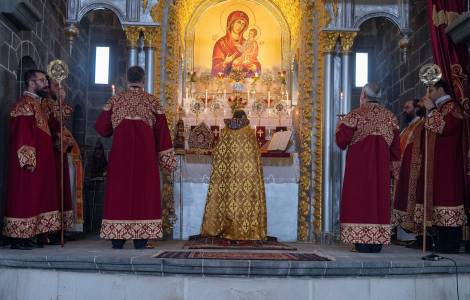
Diyarbakir (Agenzia Fides) - The Armenian Apostolic Cathedral of St Giragos in the Turkish city of Diyarbakir reopens for religious services. This also provides an opportunity to review the status of relations between the Turkish government and the Armenian Apostolic Faith Community, the largest of the many small Christian communities in Turkey today.
St Cyriacus Church reopened for worship for the first time in 2012 after decades of neglect. Shortly after reopening, the Christian church of the local Armenian community was again taken away after it was damaged leading to renewed clashes between the Turkish army and pro-Kurdish independence paramilitary groups linked to the Kurdistan Workers' Party (PKK).
The conflict between the Turkish army and Kurdish militias that began in July 2015 was the bloodiest in two decades. As
reported by Fides Agency (see Fides, 30/3/2016), the government in Ankara had ordered the expropriation of the cathedral and all other churches in the metropolis on the Tigris in March 2016 as part of the military operations in southern Turkey against Kurdish PKK positions. The expropriation decision affected a total of five churches in Diyarbakir and more than 6,000 houses, most of which are located in the historic center of the Turkish city.
The official reopening of the church last Saturday afternoon, May 7, was attended by several national and local ecclesiastical and political authorities, including Armenian Patriarch of Constantinople Sahak II Mashalyan and Turkey's Minister of Culture and Tourism, Mehmet Nuri Ersoy.
In his speech, Minister Ersoy pointed out that in Diyarbakir "different cultures and beliefs coexist in peace" and the different communities freely practice the practices and worship related to their beliefs. The minister expressed the hope that the places of worship "will be a sign of respect and brotherhood among us throughout Anatolia," stressing the importance of protecting and preserving them. Explaining that he shares the joy of the Armenian community, the Turkish politician recalled the historical importance of the reopened holy site: "We know how important this building is not only for our citizens in the city, but also for the world cultural heritage. The largest Armenian church in the Middle East reopens. I believe that this restoration, which cost about 32 million Turkish lira, is of great importance for the protection of cultural heritage".
The Armenian Patriarch Sahak II also confirmed in his speech that the restoration of the church and its reopening for worship was only possible thanks to the funds made available by the government in Ankara. "There is no doubt," added the Patriarch, "that this opening is a day of celebration for the Armenians of Diyarbakir. Even with the numerical decline in the Christian presence in Diyarbakir, the opening of this church can be a lifeline. And it contains an important and meaningful message of friendship with a view to improving Turkish and Armenian relations".
The historic Marian Monastery in Sumela in the northern Turkish province of Trabzon was reopened to visitors at the beginning of May after more demanding conservation work had been carried out to protect the monastery complex from the risk of landslides. The monastery is particularly dear to Orthodox Christians. According to tradition, the monastery (now Meryemana Manastırı, i.e. the Monastery of Mother Mary) was founded by the Greek monks Barnabas and Sophronius, who arrived there in 385 AD, during the reign of Emperor Theodosius I, after hearing an apparition received instructions from the Virgin Mary.
The location and the fortifications built over time made the monastery untouchable for centuries. In 532, after returning from one of his campaigns against the Persians, the Byzantine Emperor Justinian donated a silver urn containing the relics of Saint Barnabas to the monastery. The monastery remained a settlement of Christian monastic life during the Ottoman Empire until the last events of the First World War and the Greco-Turkish War: The monks only left the monastery for good in 1923. After decades of looting and neglect, the Turkish authorities began restoration work in the 1990s to protect the site as an archaeological-monumental complex of cultural importance, rarely allowing liturgies to be celebrated at the site important to the Byzantine monastic tradition. (GV) (Agenzia Fides, 9/5/2022)
 ASIA/LEBANON - General Abagnara (UNIFIL): “The Pope’s visit confirms us in our peacekeeping mission”
ASIA/LEBANON - General Abagnara (UNIFIL): “The Pope’s visit confirms us in our peacekeeping mission”
 ASIA/VIETNAM - Vietnamese Catholic communities stand alongside women in need to combat mass abortion
ASIA/VIETNAM - Vietnamese Catholic communities stand alongside women in need to combat mass abortion